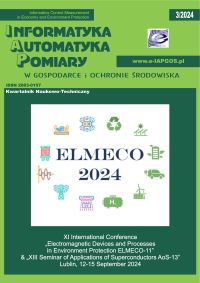ROZMYTE PODEJŚCIE DO LOKALIZACJI URZĄDZEŃ NA PODSTAWIE SIŁY SYGNAŁU SIECI BEZPRZEWODOWYCH
Michał` Socha
Research Network Łukasiewicz, Institute of Innovative Technologies EMAG, Katowice, Poland (Polska)
https://orcid.org/0000-0002-7439-4001
Wojciech Górka
Research Network Łukasiewicz, Institute of Innovative Technologies EMAG, Katowice, Poland (Polska)
https://orcid.org/0000-0003-2124-7734
Marcin Michalak
Marcin.Michalak@emag.lukasiewicz.gov.plResearch Network Łukasiewicz, Institute of Innovative Technologies EMAG, Katowice, Poland (Polska)
https://orcid.org/0000-0001-9979-8208
Abstrakt
W pracy przedstawiono oryginalną metodę lokalizowania urządzeń w budynku. Nowa metoda bazuje na mapie poszczególnych pomieszczeń, stworzonej w oparciu o pomiary sygnałów sieci bezprzewodowych zmierzonych w tych pomieszczeniach. Wstępnie urządzenie przypisywane jest do tych pomieszczeń, których opis w odpowiednim stopniu pokrywa się z pomiarami dokonanymi przez urządzenie. Stopień rozmytej przynależności do każdego z wstępnie wytypowanych pomieszczeń zależy z kolei od różnicy pomiędzy uśrednionymi wartościami sygnałów sieci bezprzewodowych i aktualnie zmierzonymi do celów lokalizacji. Ostatecznie urządzeniu przypisywane jest to pomieszczenie, dla którego stopień przynależności jest największy.
Słowa kluczowe:
sieci bezprzewodowe, zbiory rozmyte, lokalizowanie urządzeńBibliografia
Bahl P., Padmanabhan V. N.: RADAR: An in-building RF-based user location and tracking system. Proceedings IEEE INFOCOM 2000, 775–784.
Google Scholar
Benavente-Peces C. et al.: Global System for Localization and Guidance of Dependant People: Indoor and Outdoor Technologies Integration. Lecture Notes in Computer Science 5597, 2009, 82–89.
DOI: https://doi.org/10.1007/978-3-642-02868-7_11
Google Scholar
Chintalapudi K., PadmanabhaIyer A., Padmanabhan V.: Indoor localization without the pain. Proceedings of the sixteenth annual international conference on Mobile computing and networking, 2010, 173–184.
DOI: https://doi.org/10.1145/1859995.1860016
Google Scholar
Chung J. et al.: Indoor Location Sensing Using Geo-Magnetism. Proceedings of the 9th International Conference on Mobile Systems, Applications, and Services, 2011, 141–154.
DOI: https://doi.org/10.1145/1999995.2000010
Google Scholar
Enge P., Misra P.: Special issue on Global Positioning System. Proceedings of the IEEE 87(1), 1999, 3–15.
DOI: https://doi.org/10.1109/JPROC.1999.736338
Google Scholar
Galván-Tejada C. E., Carrasco-Jimenez J. C., Brena R.: Location Identification Using a Magnetic-Field-Based FFT Signature, Lecture Notes in Computer Science 8276, 2013, 9–16.
DOI: https://doi.org/10.1016/j.procs.2013.06.071
Google Scholar
Garcia-Valverde, T., Garcia-Sola, A., Hagras, H., Dooley, J. A., Callaghan, V., Botia, J. A.: A fuzzy logic-based system for indoor localization using WiFi in ambient intelligent environments. IEEE Transactions on Fuzzy Systems 21(4), 2013, 702–718.
DOI: https://doi.org/10.1109/TFUZZ.2012.2227975
Google Scholar
Górka W., Piasecki A. Socha M.: Mobile application supporting universal access to culture, taking into account the needs of disabled people. Proceedings of the 11th Scientific Conference Internet in the Information Society, 2016, 191–201.
Google Scholar
Hammadi O.A., Hebsi A. A., Zemerly M. J., Ng J. W. P.: Indoor localization and guidance using portable smartphones. Proceedings of the IEEE/WIC/ACM International Conferences on Web Intelligence and Intelligent Agent Technology, 2012, 337–341.
DOI: https://doi.org/10.1109/WI-IAT.2012.262
Google Scholar
Hernández N., Alonso J. M., Ocaña M.: Hierarchical Approach to Enhancing Topology-based WiFi Indoor Localization in Large Environments. Journal of Multiple-Valued Logic and Soft Computing 26(3-5), 2016, 221–241.
Google Scholar
Herranz, F., Llamazares, Á., Molinos, E., Ocaña, M., Sotelo, M. A.: WiFi SLAM algorithms: An experimental comparison. Robotica, 34(4), 2016, 837–858.
DOI: https://doi.org/10.1017/S0263574714001908
Google Scholar
Krumm J., Horvitz E.: Locadio: Inferring motion and location from Wi-Fi signal strengths. Prpceedings of The First Annual International Conference on Mobile and Ubiquitous Systems: Networking and Services, 2004, 4–13.
Google Scholar
Liu H. et al: Survey of wireless indoor positioning techniques and systems. IEEE Transactions on Systems, Man, and Cybernetics, Part C (Applications and Reviews) 37:6, 2007, 1067–1080.
DOI: https://doi.org/10.1109/TSMCC.2007.905750
Google Scholar
López E., Barea R., Bergasa L. M., Escudero M. S.: A human-robot cooperative learning system for easy installation of assistant robots in new working environments. Journal of Intelligent and Robotic System 40(3), 2004, 233–265.
DOI: https://doi.org/10.1023/B:JINT.0000038952.66083.d1
Google Scholar
Polito S. et al.: Performance evaluation of active RFID location systems based on RF power measures. IEEE 18th International Symposium on Personal, Indoor and Mobile Radio Communications, 2007, 1–5.
DOI: https://doi.org/10.1109/PIMRC.2007.4394676
Google Scholar
Priyantha N. B., Chakraborty A., Balakrishnan H.: The cricket location support system. Proceedings of the Annual International Conference on Mobile Computing and Networking, 2000, 32–43.
DOI: https://doi.org/10.1145/345910.345917
Google Scholar
Steinbuss S., Holtkamp B., Opriel S.: HANDELkompetent – Situation Aware Learning in Retail. Procedia Manufacturing 9, 2017, 245–253.
DOI: https://doi.org/10.1016/j.promfg.2017.04.048
Google Scholar
Want R., Hopper A., Falcao V., Gibbons J.: The Active Badge Location System. ACM Transactions on Information Systems 10(1), 1992, 91–102.
DOI: https://doi.org/10.1145/128756.128759
Google Scholar
Youssef M., Agrawala A.: The Horus WLAN location determination system. Proceedings of the 3rd international conference on Mobile systems, applications, and services, 2005, 205–218.
DOI: https://doi.org/10.1145/1067170.1067193
Google Scholar
Zadeh L.: Fuzzy sets. Information and Control 8(3), 1965, 338–353.
DOI: https://doi.org/10.1016/S0019-9958(65)90241-X
Google Scholar
Zaruba G., Huber M., Kamangar F., Chlamtac I.: Indoor location tracking using RSSI readings from a single Wi-Fi access point. Wireless Networks 13(2), 2007, 221–235.
DOI: https://doi.org/10.1007/s11276-006-5064-1
Google Scholar
Autorzy
Michał` SochaResearch Network Łukasiewicz, Institute of Innovative Technologies EMAG, Katowice, Poland Polska
https://orcid.org/0000-0002-7439-4001
Autorzy
Wojciech GórkaResearch Network Łukasiewicz, Institute of Innovative Technologies EMAG, Katowice, Poland Polska
https://orcid.org/0000-0003-2124-7734
Autorzy
Marcin MichalakMarcin.Michalak@emag.lukasiewicz.gov.pl
Research Network Łukasiewicz, Institute of Innovative Technologies EMAG, Katowice, Poland Polska
https://orcid.org/0000-0001-9979-8208
Statystyki
Abstract views: 265PDF downloads: 182
Licencja

Utwór dostępny jest na licencji Creative Commons Uznanie autorstwa – Na tych samych warunkach 4.0 Miedzynarodowe.








